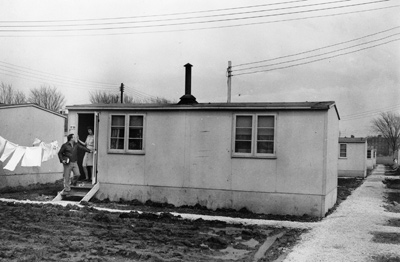Lincoln Hall Project
Stadium Terrace Intruders

By Paul T. Bryant, PhD ’65, English
The flimsy, ramshackle temporary buildings of Stadium Terrace are only a distant memory now, but for years following World War II they provided necessary housing for married students.
Our first apartment in Stadium Terrace in 1956 was in the building nearest the Betatron. The joke in our little community was that we had the only lead-lined bedroom in Champaign-Urbana. As it turned out, nuclear radiation was not our most obvious problem.
One evening soon after we moved in, neighbors stopped in for a visit. As we chatted, Genevieve, my wife, mentioned her curiosity about a hole in the metal base of the kitchen stove, visible from the living room area. The hole was clearly not part of the original manufactured form of the stove. Rather, it seemed to have been punched randomly into what was supposed to be a solid sheet of metal.
“Oh,” said our guests, laughing. “That’s a bullet hole.”
They told us a previous tenant had been sitting in the living room one evening, reading. He looked up to see a live possum peering at him around the corner of the kitchen stove. When the student moved to stand up, the possum disappeared into the kitchen cabinetry.
Not wanting to pursue the possum through the nooks and crannies of the apartment, the student retrieved a handgun from the bedroom, loaded it, and sat back down to read. After a while, he again saw the possum peering at him around the corner of the stove. Grabbing up his gun, he fired at the intruder, missing the possum but hitting the unoffending stove. Hence the hole.
Apparently the possum fled and did not return, so there was no further gunplay. Still, I was concerned that an animal of that size could get into the apartment. I began poking around under the kitchen counters and in the cabinets and found that there were several large holes opening into the hollow walls. The building was not on a solid, continuous foundation, so there was free access for animals to get under the building and then up into the walls.
I mustered boards from some wooden boxes, and soon had the openings sealed up. To stop not only large animals, but also mice, I crammed steel wool around the small gaps where pipes or electric cable came through the walls. Problem solved—or so I thought.
As fall weather cooled and nights became frosty, field mice began to migrate into the building. Everyone set traps, but the mice kept coming. Tenants complained of the mouse invasion, so the physical plant people undertook to do something about it: put poisoned grain several places under the building.
Unfortunately, the effect of the poison was to make the dying mice seek water. The closest source of water was the condensation on the water pipes in the building’s walls. The result was the stench of rotting mice scattered through the walls. We could do nothing but wait it out. Given our proximity to the Betatron, I couldn’t help but wonder if any of the dead mice were radioactive.
The views expressed in Storyography are not necessarily those of the College of Liberal Arts and Sciences or the University of Illinois.
